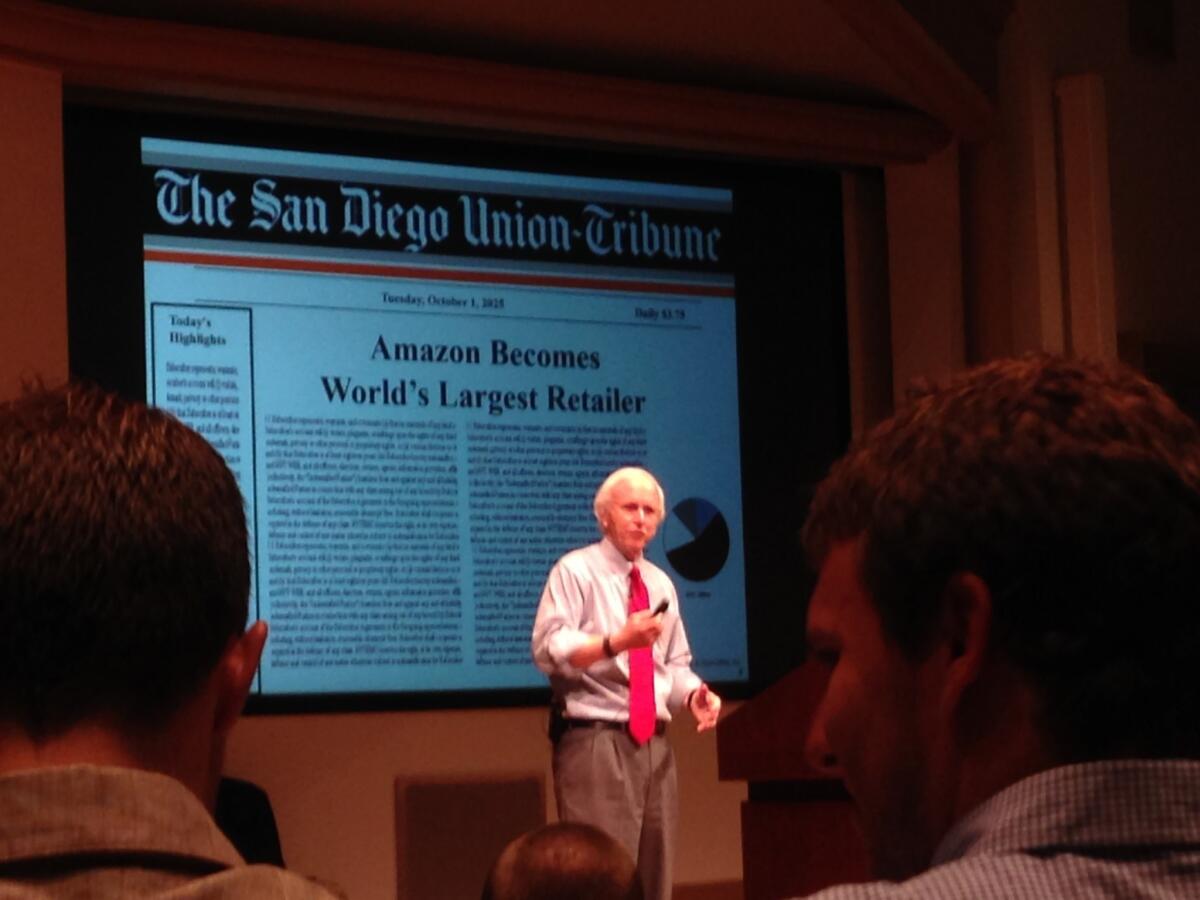Real estate guru warns market peak is near

Real estate brokers are “toast,” retail centers are “burnt toast” and the current economic boom is about to peak.
So said Christopher Lee, CEO and president of CEL & Associates, a leading industry consultant who addressed a Thursday forum sponsored by the University of San Diego Burnham-Moores Center for Real Estate.
“This has got to be some of the best times to be in real estate,” he said. “Real estate is in an incredible transformation, not a transition. So many things are changing at a rapid accelerated pace in the way we do business.”
Brokers are obsolete, Lee said told an audience of about 250, because their clients can find most information they need directly.
“Google is the No. 1 source for selling real estate,” he said, so brokers will become consultants, similar to advisers at accounting firms.
Retail centers are so-yesterday — “We might as well give them their last rites right now,” he said — because of online shopping.
“Many retail centers are going to be updated and no longer utilized as retail centers as you know them,” he said. “It’s done, it’s over.”
Instead, he said, bars, restaurants and other activities will take the place of brick-and-mortar shops. Consumers will visit to participate in 10-K races or check out popup consumer shows, such as camping equipment displays.
Based on the last 50 years of economic cycles, Lee said the current boom is likely to end in 2017, ‘18 or ‘19 and another upturn may begin in 2023. It will be characterized by “globalizing and knowledge.” The generation raised on the Internet, transparency, relationship-driven interaction and new technologies will be in charge.
On the residential side, Lee said homeownership by 2025 will drop below 60 percent, down from the record 69.2 percent in the mid-2000s.
“People are not buying homes — they are renting — and we will continue to move to a rental-based society,” he said. “Uber, Lyft, iTunes, Airbnb: You name it, you’re out there doing it. It’s all about renting, not owning.”
When asked about millennials moving to the suburbs to buy homes when they have children, Lee predicted many baby boomer parents will rent not sell their houses to the younger generation and downsize to rented apartments in central cities.
In San Diego the affordability problem will accentuate such a trend.He noted that only 44 percent of San Diegans earning the median income can afford the median-priced home. In Atlanta, it’s 77.8 percent.
“This is where you want to be if you’re in multifamily (housing investment and construction),” he said. “San Diego is a great place to be because no one can afford anything. Keep wages and down and it’s even better (for multifamily investors).”
Among 100 predictions he has come up with for the next 10 years, Lee offered these:
- Buildings will be fined and taxed if they are not energy efficient and water-wise. “Every one of these things is making real estate the ‘energy czar’ for America.” He also said the federal government is likely to pass a mandatory building code that property owners will have to follow.
- Commercial buildings will include some form of urban farming, starting with the use of 700,000 excess shipping containers.
- Women will represent 40 percent of individuals in the “C suite” for CEOs, CFOs and chief technology officers. They will make decisions on leases, capital and other important matters.
- Coworking spaces will become more common as a way to utilize office buildings 24 hours a day rather than just from 8 a.m. to 5 p.m.
- Warehouses and other industrial buildings will employ robots and robots will build buildings. Consequently some 10 million jobs for humans will disappear. “I don’t know what we’re going to do with all the people.”
- Young real estate graduates will have the pick of plum industry jobs because of retiring baby boomers. “There’s not enough of you and not enough good ones and smart ones. Don’t take the cheap stuff (job offers).”
- Despite the rent-not-own trends, he said, first-time buyers with enough savings should act now because of low interest rates and plan to stay in place for several years, implying that flipping houses won’t be an option in many cases.
2025 predictions
Christopher Lee made 100 predictions in his Strategic Advantage newsletter. Here’s a selection of real-estate-related possibilities beyond those mentioned above:
- “By 2025, 25-30 percent of real estate firms in existence in 2015 will be gone via merger, acquisition, bankruptcy, retirement or inability to compete.”
- “Big data, when combined with health monitoring, will make apartment units and personal computers the gateway to preventive and ongoing medical diagnoses.”
- “Homes, apartments, work stations and workplace environments will become smaller.”
- “As much as 35 to 45 percent of current office work will be conducted away from the office.”
- “The average number of square feet per employee in office buildings will shrink to less than 100 square feet (down from about 250 square feet).”
- “Within a decade, there will be thriving underground parks, office and retail complexes.”
- “By 2025 the real estate industry should see the first of many ‘floating cities’ under construction with a 2030 date for occupancy.”
- “Over the next decade, expect water shortages to impact the ‘desirability’ of several U.S. cities.” (San Diego is not mentioned.) “Housing affordability will be the political focus over the next decade.”
-
roger.showley@sduniontribune.com; (619) 293-1286; Twitter: @rogershowley
Get U-T Business in your inbox on Mondays
Get ready for your week with the week’s top business stories from San Diego and California, in your inbox Monday mornings.
You may occasionally receive promotional content from the San Diego Union-Tribune.
